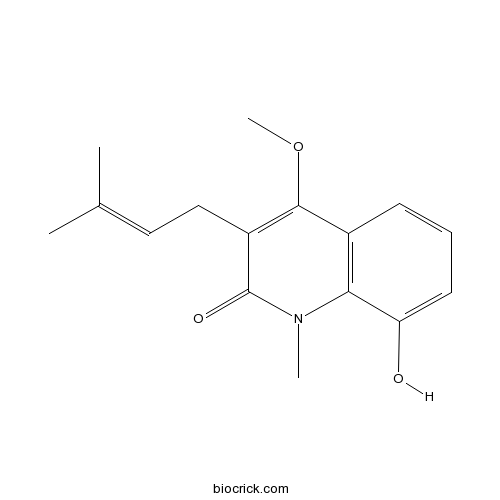GlycosoloneCAS# 67879-81-6 |

Quality Control & MSDS
3D structure
Package In Stock
Number of papers citing our products

| Cas No. | 67879-81-6 | SDF | Download SDF |
| PubChem ID | 155059 | Appearance | Powder |
| Formula | C16H19NO3 | M.Wt | 273.3 |
| Type of Compound | Alkaloids | Storage | Desiccate at -20°C |
| Solubility | Soluble in Chloroform,Dichloromethane,Ethyl Acetate,DMSO,Acetone,etc. | ||
| Chemical Name | 8-hydroxy-4-methoxy-1-methyl-3-(3-methylbut-2-enyl)quinolin-2-one | ||
| SMILES | CC(=CCC1=C(C2=C(C(=CC=C2)O)N(C1=O)C)OC)C | ||
| Standard InChIKey | KBMGLVFFJUCSBR-UHFFFAOYSA-N | ||
| Standard InChI | InChI=1S/C16H19NO3/c1-10(2)8-9-12-15(20-4)11-6-5-7-13(18)14(11)17(3)16(12)19/h5-8,18H,9H2,1-4H3 | ||
| General tips | For obtaining a higher solubility , please warm the tube at 37 ℃ and shake it in the ultrasonic bath for a while.Stock solution can be stored below -20℃ for several months. We recommend that you prepare and use the solution on the same day. However, if the test schedule requires, the stock solutions can be prepared in advance, and the stock solution must be sealed and stored below -20℃. In general, the stock solution can be kept for several months. Before use, we recommend that you leave the vial at room temperature for at least an hour before opening it. |
||
| About Packaging | 1. The packaging of the product may be reversed during transportation, cause the high purity compounds to adhere to the neck or cap of the vial.Take the vail out of its packaging and shake gently until the compounds fall to the bottom of the vial. 2. For liquid products, please centrifuge at 500xg to gather the liquid to the bottom of the vial. 3. Try to avoid loss or contamination during the experiment. |
||
| Shipping Condition | Packaging according to customer requirements(5mg, 10mg, 20mg and more). Ship via FedEx, DHL, UPS, EMS or other couriers with RT, or blue ice upon request. | ||
| Description | 1. Glycosolone shows some toxicity on mosquito larvae (Culex quinquefasciatus). |

Glycosolone Dilution Calculator

Glycosolone Molarity Calculator
| 1 mg | 5 mg | 10 mg | 20 mg | 25 mg | |
| 1 mM | 3.659 mL | 18.2949 mL | 36.5898 mL | 73.1797 mL | 91.4746 mL |
| 5 mM | 0.7318 mL | 3.659 mL | 7.318 mL | 14.6359 mL | 18.2949 mL |
| 10 mM | 0.3659 mL | 1.8295 mL | 3.659 mL | 7.318 mL | 9.1475 mL |
| 50 mM | 0.0732 mL | 0.3659 mL | 0.7318 mL | 1.4636 mL | 1.8295 mL |
| 100 mM | 0.0366 mL | 0.1829 mL | 0.3659 mL | 0.7318 mL | 0.9147 mL |
| * Note: If you are in the process of experiment, it's necessary to make the dilution ratios of the samples. The dilution data above is only for reference. Normally, it's can get a better solubility within lower of Concentrations. | |||||

Calcutta University

University of Minnesota

University of Maryland School of Medicine

University of Illinois at Chicago

The Ohio State University

University of Zurich

Harvard University

Colorado State University

Auburn University

Yale University

Worcester Polytechnic Institute

Washington State University

Stanford University

University of Leipzig

Universidade da Beira Interior

The Institute of Cancer Research

Heidelberg University

University of Amsterdam

University of Auckland

TsingHua University

The University of Michigan

Miami University

DRURY University

Jilin University

Fudan University

Wuhan University

Sun Yat-sen University

Universite de Paris

Deemed University

Auckland University

The University of Tokyo

Korea University
- Caftaric acid
Catalog No.:BCN2096
CAS No.:67879-58-7
- Boc-Nva-OH.DCHA
Catalog No.:BCC2642
CAS No.:67861-96-5
- Taraxasterone
Catalog No.:BCN7746
CAS No.:6786-16-9
- Ethyl 2,4-dihydroxyphenylacetate
Catalog No.:BCN4235
CAS No.:67828-62-0
- Methyl 2,4-dihydroxyphenylacetate
Catalog No.:BCN6801
CAS No.:67828-42-6
- 2,3,2'',3''-Tetrahydroochnaflavone
Catalog No.:BCN4234
CAS No.:678138-59-5
- MRK 560
Catalog No.:BCC2345
CAS No.:677772-84-8
- Menisdaurin
Catalog No.:BCN2552
CAS No.:67765-58-6
- 2-(2,4-Dihydroxyphenyl)-6-hydroxybenzofuran
Catalog No.:BCN7546
CAS No.:67736-22-5
- PIK-90
Catalog No.:BCC1248
CAS No.:677338-12-4
- iCRT 14
Catalog No.:BCC5401
CAS No.:677331-12-3
- TG100-115
Catalog No.:BCC1247
CAS No.:677297-51-7
- Deapi-platycodin D3
Catalog No.:BCN3240
CAS No.:67884-05-3
- Martynoside
Catalog No.:BCN4236
CAS No.:67884-12-2
- n-Butyl-β-D-fructopyranoside
Catalog No.:BCC9097
CAS No.:67884-27-9
- Gigantol
Catalog No.:BCN8382
CAS No.:67884-30-4
- Cyclo(Pro-Trp)
Catalog No.:BCN2422
CAS No.:67889-75-2
- Scutebarbatine K
Catalog No.:BCN3223
CAS No.:960302-86-7
- Ambrox
Catalog No.:BCN6907
CAS No.:6790-58-5
- Aluminum n-octacosoxide
Catalog No.:BCC8099
CAS No.:67905-27-5
- Dehydroevodiamine
Catalog No.:BCN2974
CAS No.:67909-49-3
- Homobaldrinal
Catalog No.:BCN2681
CAS No.:67910-07-0
- Macusine B
Catalog No.:BCN6471
CAS No.:6792-07-0
- Mesaconine
Catalog No.:BCC8339
CAS No.:6792-09-2
Studies of Some Alkaloids for Toxicity on the Larvae of Culex quinquefasciatus
Indian Journal of Environmental Health, 1996 , 38 (2) :81-5.
Toxicity tests of some alkaloids, isolated from Glycosmis pentaphylla, Murraya koenigii and Piper nigrum and their derived products reveal that the alkaloid piperine obtained from Piper nigrum has highest toxicity on mosquito larvae (Culex quinquefasciatus). But the two derived products, piperonal and piperonylic acid from piperine, show no mortality at 100 ppm at an interval of 24 hours. Though glycozoline and glycozolidine (obtained from Glycosmis pentaphylla) are non-toxic at 100 ppm, other alkaloid Glycosolone shows some toxicity. Monohydroxy compounds obtained from glycozoline and glycozolidine have high and similar type of toxicity like that of mahanimbine.


